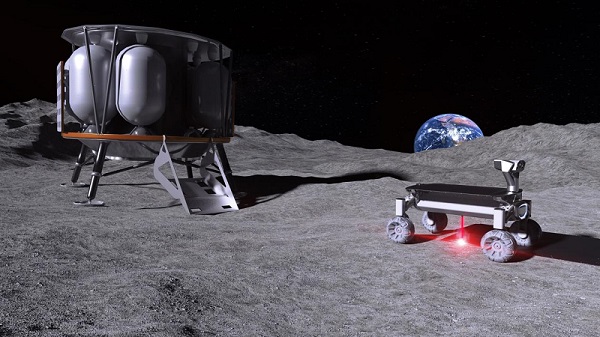Scientists from the Laser Zentrum Hannover eV (LZH) and the Technische Universität Berlin (TU Berlin) are planning a flight to the moon to melt lunar dust with laser radiation. Researchers, on a project called MOONRISE, are looking to AI-aided lasing for the 3D printing of landing sites, roads, or buildings, using lunar dust.
Pulverized lunar rock, or regolith, is abundant on the moon and could be used as a raw material for 3D printing. Onsite fabrication of infrastructure could save enormous transportation costs. The use and processing of onsite materials, known as in situ resource utilization, or ISRU in spaceflight, could be a crucial factor in advancing the exploration of the moon and space.
Because the far side of the moon is always turned away from Earth, it is considered a prime spot for powerful space telescopes; the European Space Agency, therefore, has plans for a “moon village.” The lower gravity and lack of an atmosphere make the moon an ideal stopover for setting up missions to more distant destinations in space. However, the problem of launch pads, landing sites, and buildings remains an expensive one.

The MOONRISE project technology will be used on the moon to melt lunar dust with a laser. Project results will inform researchers on the viability of moon-based infrastructure. Courtesy of LZH.
“At a cost of up to a million dollars per kilogram, a complete transport of the material from Earth to the moon would be extremely expensive,” said Jörg Neumann, MOONRISE project manager at LZH.
In a predecessor project funded by the Volkswagen Foundation, the team developed a laser and tested it in the laboratory on the robotic arm of a lunar rover. The scientists also smelted regolith under lunar gravity in the Einstein-Elevator of the Hannover Institute of Technology at Leibniz Universität Hannover.
The task now is to make the laser fit for lunar flight. The scientists from LZH and TU Berlin want to develop a flight model of the laser that is qualified for use in space. The laser will be supported by trained AI.
To train the AI, the researchers will photograph the regolith under lighting conditions that mimic those on the moon. This will allow a corresponding pool of images to be created.
“In addition, a regolith construction kit has been developed over the past few years, which allows the various possible landing sites to be precisely recreated in terms of properties,” said Benedict Grefen from the group “Exploration and Propulsion” at TU Berlin. “This is then adapted in the project to the final landing site on the moon, so that in the laboratory the laser and the AI can be aligned with the real lunar mission.”
The “surface analog model” created in this way will also support decision-making during the mission.
Once the technology is deployed on the moon, a camera will take photos of the lunar dust melted by the laser. Researchers will analyze these photos with the help of an intelligent image processing system.
The MOONRISE FM project will run for three years and is funded by the German Federal Ministry of Economics and Climate Action with €4.75 million ($5 million). The mission is scheduled to launch in 2024.